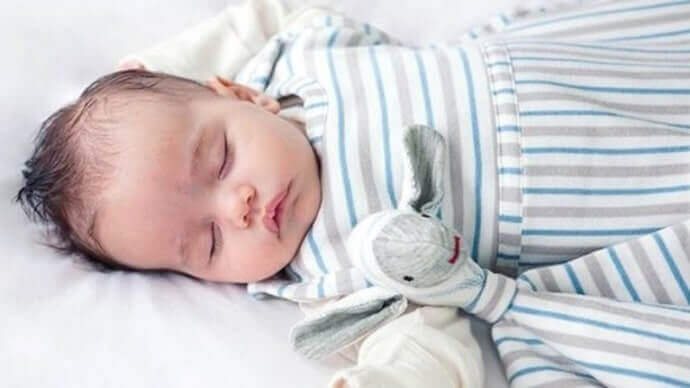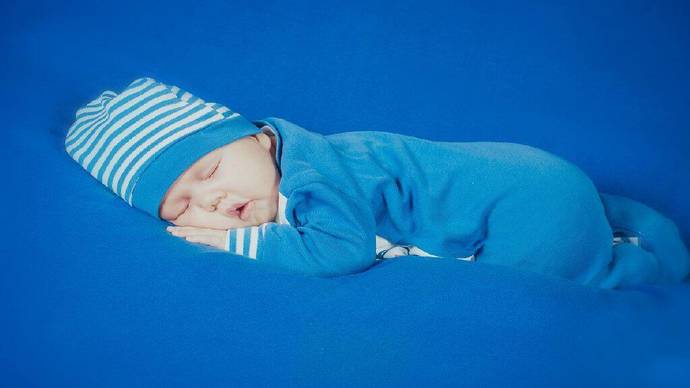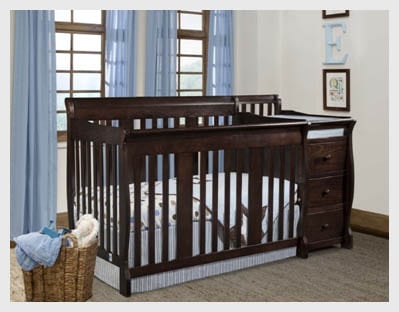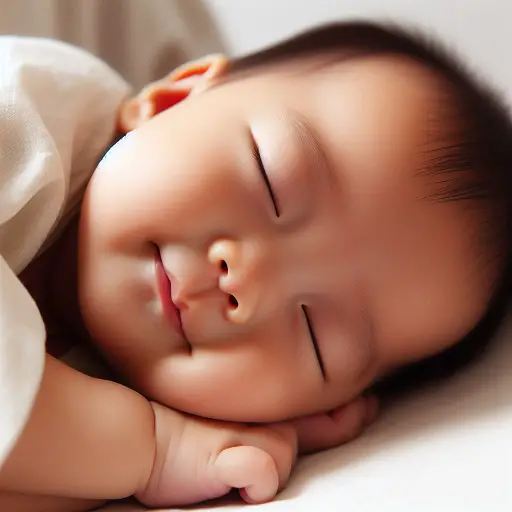Your baby has spent nine months in a safe, snug and secure environment in your womb during which it felt a constant light pressure of your uterus which gave it a “hug” like feeling. Now after the baby is born and getting accustomed to the outside environment it will feel the absence of ‘constant hug-like feeling’ which may result in baby getting startled while sleeping.
You may have also noticed that the baby flails it’s little arms out wide when startled in sleep, That’s called the “Moro” reflex or “startle reflex” and though it usually only lasts a few seconds, it’s often enough to wake your sleeping baby.
Some researchers believe this is a primitive survival instinct which was meant to alert the infant that is loosing balance which helped them to prevent losing grip of the mother.

What causes a baby getting startled while sleeping?
Any unfamiliar stimuli (that with which baby was not accustomed in the womb) can trigger startled response.
For example any sudden changes in the environment like a loud noise, a sudden touch, an abrupt change of light intensity. It may also happen by any event that makes the baby feel off balance like when you are lowering the baby to place it in a crib or taking him out of a bathtub. Startled reflex can also be triggered by a change from one surface to another or any experience that alters the level of support the baby was feeling.
For you some of these triggers may be so insignificant , that you won’t even notice them. But to your baby who, up until now, was used to live in the womb, even the smallest of changes can evoke this startle reflex.
Is startle reflex bad for babies?
Not at all. Startle reflex is absolutely normal for a newborn or a baby which is three to four months old. In fact, the absence of the startle reflex is abnormal in a new baby and maybe an indication of some problem in the baby’s nervous system. Read more here what absence of startle reflex means for a baby.
When does startle reflex in babies go away?
By the time your baby’s about six weeks old, he’ll acclimate to life outside the womb and gradually feel more secure in his surroundings. His startle reflex will start decreasing and ultimately disappear around the 4th month sometimes around 5th month. So till then, try to offer your infant lots of extra support to give him the secure feeling like swadling to help him feel snug.
Does swaddling help startle reflex?
Yes. Swaddling helps to recreate a womb-like environment giving the baby snug and secure feeling, which can help soothe baby while he is experiencing startle reflex. Swaddling which has been around forever and involves wrapping the baby so that it creates a light pressure and continuous edges or touching – replicating the sensation when the baby was in the womb.
Swaddling your little one helps to keep his arms snug, to prevent that feeling of free fall they can experience, and result in awaking from sleep. Some doctors like Dr. Harvey Karp reports that when swaddled babies sleep an extra 1-3 hours.
For those who are not aware, a swaddle is a fabric that wraps around the baby’s body like a cozy cocoon.
Did you know, traditional swaddles are simple square blankets that require complicated tucking and folding to get a snug fit?
On the other hand, the Zen Swaddle uses secure fasteners for an easy, adjustable fit to keep baby’s tiny limbs in place so they don’t startle awake.
Swaddling works best to calm Moro Reflex if it is introduced right after birth. Making swaddling a part of your baby’s naptime ritual early on will help create the association that once the swaddle is on, it’s time for sleep.
Zen Swaddle is lightly weighted to mimic your gentle touch, its consistent use helps teach babies to self soothe as they get older. The added gentle pressure acts as your touch and helps keep baby calm, so even if they stir, they can fall right back asleep on their own.
When should we stop swaddling your baby?
Is your baby getting startled while sleeping? As your baby grows stronger and gets accustomed to the environment outside, the startle reflex starts going down and vanishes around 5th month. This is generally the time to stop swaddling.
However, most babies sleep so well when swaddled that many new moms may delay transitioning the growing baby out of the swaddle which is not good for the baby’s growth.
Although the exact time for transitioning the baby from the swaddle , will vary for each baby, somewhere between 4 to 6 months, the baby will show signs that it may be time to stop swaddling.
When your baby starts doing any of the following, it is a signal that you should start plan to transition the baby from a swaddle:
- Taking its arms out of swaddle while sleeping and Increase in activity in general.
- Becoming too mobile to stay swaddled through the night.
- Starts trying to rollover due to increased arm and neck strength.
- Starts waking up in the middle of the night although having a history of sleeping well.
- Decreased or no startle reflex
To sum it up, startle reflex starts at birth and ends around 4-6 months. This is also the same time around which your baby is strong enough to roll over. So it is a good practice to start swaddling at birth and end it around 4-6 months.
Baby rolling but still has startle reflex?
For some babies, the feeling of security of being swaddled is preferred long even after the startle reflex has disappeared. At the same time, swaddling no longer keeps them satisfied as they want to free their limbs from the tight cocoon. As the baby grows stronger and learns to escape the swaddle, or starts to attempt roll over while swaddled it poses a safety risk.
To handle this situation try this:
1) When you lower your sleeping baby into its crib or bassinet, keep him as close to your body as possible for as long as possible. Hug your baby while you gradually bend over. Then gradually place your baby on the mattress holding him close to your chest for a few seconds before releasing contact with your body ensuring your baby is not getting startled while sleeping.
Once he feels a mattress on his back he will usually feel secure enough not to startle.
2) Another way is to try using a transitional swaddle suit such as the SLEEPY HUGS sleepsuit, a mum designed sleepsuit that is made to help babies transition easily from the swaddle wrap. Its design helps baby to cope better with the ‘startle reflex’ as it allows baby to move his hands free-ly while still providing that enclosed, secure feeling.
What does an absent Moro reflex mean?
Absence of the Moro reflex or startle reflex in an infant means certain abnormality in the baby. Absence of startle reflex on both sides suggests the baby may have damage to the brain or spinal cord. Absence of startle reflex on any one side suggests either the baby have a broken shoulder bone or there is an injury to brachial plexus which is a group of nerves that run from the lower neck and upper shoulder.
Right after birth or during the visits your childcare provider checks the Moro reflex.
It is done by first placing the baby face-up on a soft, padded surface.
Then the head is gently lifted without lifting the infant’s body.
The head is then released suddenly, creating a feeling of sudden fall backward for a moment, but quickly supported again (of course the head is not allowed to bang on the padding).
The normal response for the baby is to have a startled reaction. The baby’s arms should move sideways with the palms up and the thumbs flexed. The baby may also cry for a minute.
As the reflex ends, the infant draws its arms back to the body, elbows flexed and then relaxes.
If this reaction is not found then it’s a sign that everything is not okay with the baby.
What does an exaggerated Moro reflex mean?
Exaggerated Moro reflex has been found to be a genetic disorder also known as hyperekplexia in which babies have an exaggerated startle reflex (reaction).
This disorder was recognized in 1962. It starts with hypertonia (stiffness), strong brain-stem reflexes (especially head-retraction reflex) and, in some cases, epilepsy. The exaggerated startle response persists throughout life and can happen even by lightly touching the person’s nose, clapping or making other noises, or suddenly jolting the person’s chair. Hope this will help and your baby will not be getting startled while sleeping.





